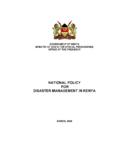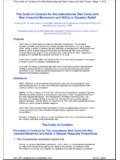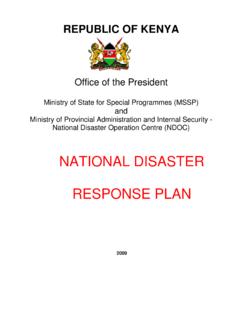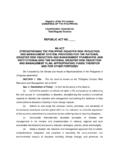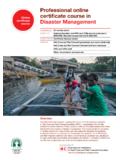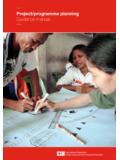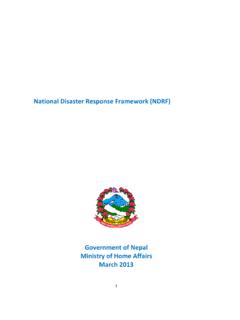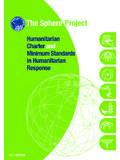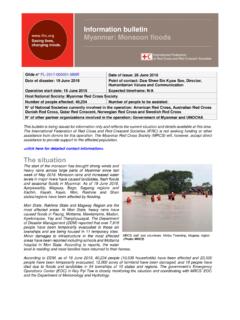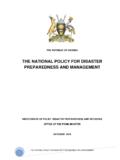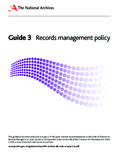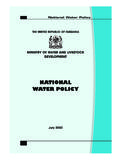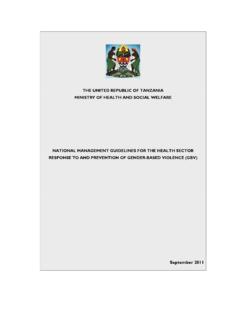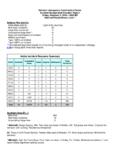Transcription of DRAFT DISASTER MANAGEMENT POLICY - IFRC.org
1 GOVERNMENT OF KENYA. MINISTRY OF STATE FOR SPECIAL PROGRAMMES. OFFICE OF THE PRESIDENT. DRAFT national POLICY . FOR. DISASTER MANAGEMENT IN KENYA. FEBRUARY 2009. LIST OF ABBREVIATIONS. ASAL Arid and Semi Arid Lands AU Africa Union CBD Convention on Biological Diversity CBOs Community Based Organizations CEWARN Conflict Early Warning and Response Network CSOs Civil Society Organisations DM DISASTER MANAGEMENT DRR DISASTER Risk Reduction ECOWAS Economic Community of West African States EWS Early Warning System GHA Greater Horn of Africa GRTS Geo Livelihood Review Teams HIV/AIDS Human Immune Virus/ Acquired Immuno-Deficiency Syndrome IGAD Inter-Governmental Authority for Development IPCC Inter-governmental Panel on Climate Change ISDR International Strategy for DISASTER Response KFSM Kenya Food Security Meeting KFSSG Kenya Food Security Steering Group M&E Monitoring and Evaluation MARPOL International Convention for Prevention of Pollution from Ships MDGs Millennium Development Goals MT Metric Tonnes MTEF Medium Term Expenditure Framework NADIMA national DISASTER MANAGEMENT Agency NGOs Non-Governmental Organizations NOAA national Oceanic and Atmospheric
2 Administration PIC Prior Informed Consent POPs Persistent Organic Pollutants PRSP Poverty Reduction Strategy Paper RAMSAR Convention on Wetlands of International Importance SADC Southern African Development Community SOP Standard Operating Procedure UN United Nations UNCBD United Nations Convention on Biological Diversity UNCCD United Nations Convention to Combat Desertification UNFCCC United Nations Framework Convention on Climate Change 2. Definitions of DISASTER MANAGEMENT Terms A Hazard: A hazard is a dangerous phenomenon, substance, human activity or condition that may cause the loss of life, injury or other health impacts, property damage, loss of livelihoods and services, social and economic disruption, or environmental damage. A Natural Hazard: Natural processes or phenomenon that may cause loss of life, injury or other health impacts, property damage, loss of livelihoods and services, social and economic disruption, or environmental damage. A Geological Hazard: Geological process or phenomenon that may cause lo loss of life, injury or other health impacts, property damage, loss of livelihoods and services, social and economic disruption, or environmental damage.
3 A Technological Hazard: A hazard originating from technological or industrial conditions, including accidents, dangerous procedures, infrastructure failures or specific human activities, that may cause loss of life, injury, illness or other health impacts, property damage, loss of livelihoods and services, social and economic disruption, or environmental damage. A DISASTER : A DISASTER is a serious disruption of the functioning of a community or society causing widespread human, material, economic or environmental loses which exceed the ability of the affected community/society to cope using its own resources. A DISASTER Risk: The potential DISASTER losses, in lives, health status, livelihoods, assets and services, which could occur to a particular community or a society over some specified future time period. DISASTER Risk MANAGEMENT : The systematic process of using administrative directives, organisations, and operational skills and capacities to implement strategies, policies and improved coping capacities in order to lessen the adverse impacts of hazards and the possibility of DISASTER .
4 DISASTER Risk Reduction: he concept and practice of reducing DISASTER risks through systematic efforts to analyze and manage the causal factors of disasters, including through reduced exposure to hazards, lessened vulnerability of people and property, wise MANAGEMENT of land and the environment, and improved preparedness for adverse events. Risk Assessment: A methodology to determine the nature and extent of risk by analyzing potential hazards and evaluating existing conditions of vulnerability that together could potentially harm exposed people, property, services, livelihoods and the environment on which they depend. FOREWORD. Kenya's DISASTER profile is dominated by droughts, fire, floods, terrorism, technological accidents, diseases and epidemics that disrupt people's livelihoods, destroy the infrastructure, 3. divert planned use of resources, interrupt economic activities and retard development. In the pursuit of reducing vulnerabilities to risks, the Government has formulated this national POLICY on DISASTER MANAGEMENT to institutionalise mechanisms for addressing disasters.
5 Recent DISASTER events, the successive Reports of the Inter-governmental Panel Climate Change (IPCC), the recent Climate Change Conference (Nairobi , Nov. 2006), and a recent comprehensive environmental reconnaissance survey over the whole country have all stressed the central role of Climate Change in any sustainable planned and integrated national Strategy for DISASTER MANAGEMENT . The POLICY emphasizes preparedness on the part of the Government, communities and other stakeholders in DISASTER Risk Reduction activities. In this regard, the POLICY aims at the establishment and strengthening of DISASTER MANAGEMENT institutions, partnerships, networking and main streaming DISASTER Risk Reduction in the development process so as to strengthen the resilience of vulnerable groups to cope with potential disasters. Ministry of State for Special Programmes in the Office of President will coordinate DISASTER Risk Reduction initiatives within a unified POLICY framework in a proactive manner at all levels.
6 DISASTER Risk MANAGEMENT encompasses a full continuum from preparedness, relief and rehabilitation, mitigation and prevention. The POLICY aims to increase and sustain resilience of vulnerable communities to hazards through diversification of their livelihoods and coping mechanisms. This entails a shift from the short term relief responses to development. The POLICY will go a long way in preserving life and minimising suffering by providing sufficient and timely early warning information on potential hazards that may result to disasters. It will also aim at alleviating suffering by providing timely and appropriate response mechanisms for DISASTER victims. The preparation of this POLICY Paper has benefited from invaluable contribution from experts in various Ministries and organizations and it is hoped that the full implementation of this POLICY will contribute immensely to DISASTER risk reduction, effective DISASTER preparedness, response, recovery and reconstruction as well as contribute to poverty reduction and sustainable development in the country, particularly among those communities that have been identified as highly vulnerable to DISASTER risk, loss of life and livelihoods.
7 HON DR. NAOMI SHAABAN, EGH, MP. MINISTER OF STATE FOR SPECIAL PROGRAMMES. 4. ACKNOWLEDGEMENTS. The conceptual need to formulate a comprehensive DISASTER MANAGEMENT POLICY came to the fore about ten years ago; and many successive efforts followed with foundation documents, which were thereafter utilised in the research to formulate a concrete DISASTER MANAGEMENT POLICY document. Subsequently, particularly over the last nearly three years, starting October 2006, the process research for formulation of the DISASTER MANAGEMENT POLICY for Kenya has been a collaborative, contributory process involving many parties, the Government, Development Partners and stakeholders at all levels, national , District and lower levels. In particular, the Ministry of Special Programmes is indebted to the consultants, Ministries, stakeholders, and personalities who laid down the foundation of the DISASTER MANAGEMENT POLICY review, by the DRAFT POLICY Document of April 2007. That Document is the basis of subsequent workshops and fieldwork for the DRAFT DISASTER MANAGEMENT POLICY Review.
8 The Ministry, set up a DISASTER MANAGEMENT POLICY Review Committee, in November 2008, made up of a Consultant, and five Committee members. Thereafter, a further five members were incorporated, including a Facilitator and two Rapporteurs. This team, in partnership with various Development Partners and stakeholders, held successive, analytical and technical workshops of various sizes and durations, to facilitate an effective review, from November 2008 to February 2009. The dutiful and committed application of there efforts and that of partners and stakeholders is particularly appreciated by the Ministry, for, without it, this document would not be a reality. Lastly, innumerable Kenyan personalities from the Universities, Research institutes, as well as International organisations (including UN agencies, Oxfam, the European Union) are especially thanked for their invaluable contributions toward the review of the DRAFT DISASTER MANAGEMENT POLICY . ALI D. MOHAMMED. PERMANENT SECRETARY.
9 MINISTRY OF SPECIAL PROGRAMMES. 5. EXECUTIVE SUMMARY. In the last two decades, Kenya has continued to face a rising degree of vulnerability to DISASTER risk. This risk is the probability of a hazard turning into a DISASTER , with households or communities being affected in such a manner that their lives and livelihoods are seriously disrupted beyond their capacity to cope or withstand using their own resources, with the result that affected populations suffer serious widespread human, material, economic or environmental losses. Communities are predisposed to disasters by a combination of factors such as poverty, aridity, settlement in areas prone to perennial flooding or areas with poor infrastructure and services such as the informal urban settlements or even living in poorly constructed buildings. These factors, coupled with naturally occurring hazards such as droughts, floods, HIV and AIDS, landslides and epidemic outbreaks, among others, and currently propelled by climatic change phenomena, pose extremely high and increasing DISASTER risks to the Kenyan society.
10 According to the Ministry of Planning and national Development, Kenya's population rose to million towards the end of 2008 and is estimated to hit the 40 million mark by 2010. This population, growing at the rate of and largely youthful (60% of the population is aged under 25 years), is bound to be adversely affected, particularly with the high poverty rates (57% of Kenyans live below the poverty line), unemployment, the HIV and AIDS scourge and an economy largely dependent on rain-fed agriculture. Life expectancy is 53% for men and 55% for women compared to and for women and men respectively in 2007. Such a population can be classified as highly vulnerable to DISASTER occurrences and any small predisposing factor may result in emergencies of high proportion, often culminating in national disasters that require external assistance. Although Kenya's economy and by extension its population could be classified as highly vulnerable to natural and man-made DISASTER risks, the country does not have a comprehensive DISASTER MANAGEMENT framework and strategies guided by appropriate POLICY and legislative provisions.
